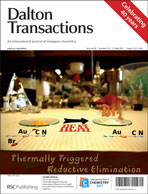Chromium(iii) stars and butterflies: synthesis, structural and magnetic studies of tetrametallic clusters†
Abstract
We report the synthesis, structures and magnetic properties of a series of chromium(III) metal-centered triangle (or “star”) clusters, [Cr4{RC(CH2O)3}2(4,4′-R′2-bipy)3Cl6] [R = Et, R′ = H (2); R = HOCH2, R′ = H (3); R = Et, R′ = tBu (4)], prepared by two-step solvothermal reactions starting from [CrCl3(thf)3]. The product of the first stage of this reaction is the salt [Cr(bipy)2Cl2]2[Cr2Cl8(MeCN)2] (1). In the absence of the diimine, a different family of tetrametallics is isolated: the butterfly complexes [Cr4{EtC(CH2O)3}2{NH(C(R)NH)2}2Cl6] (R = Me (5), Et (6), Ph (7)] where the chelating N-acetimidoylacetamidine NH(C(R)![[double bond, length as m-dash]](https://www.rsc.org/images/entities/char_e001.gif) NH)2
NH)2


 Please wait while we load your content...
Please wait while we load your content...